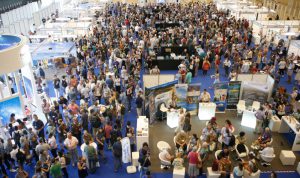
October 8, 2019, by lzzeb
The Goldschmidt conference
A blog by Professor George Swann
Why do you go to a conference? One of the most common questions I’m asked when I mention that I about to head off to such an event. Some might simply see a conference as a glorified holiday. Whilst conferences can indeed be an opportunity to travel somewhere new, in fact attending a conference is probably one of the most tiring things I do. Imagine cramming in a series of talks from 8 am – 6 pm every day for a week. Yes, there’s the odd coffee break or other meeting to break up the day, but why do I and my colleague put ourselves through this? Well, conferences are a unique opportunity to hear the latest discoveries in our field and to listen to scientists at the very forefront of our discipline show off their latest discoveries. Conferences are also a great opportunity to organise meetings (having everyone from different universities at the same conference significantly cuts down on the need to travel to countless other project meetings throughout the year) and, perhaps most importantly for me, listening to others talk about their latest findings is a huge source of inspiration from which to motivate new ideas/research.
The annual Goldschmidt conference ticks all of the above boxes (www.eag.eu.com/about/goldschmidt/2019report/). As the main conference each year specialising in geochemistry and attended by over 4,000 fellow scientists, the event is a fantastic opportunity to hear about everyone’s latest research and how science is progressing. Held this year in Barcelona and having decided to travel there by train (after spending a large number of my lectures telling students that we all need to make changes to our lifestyle in order to successfully combat climate change, I’d be a hypocrite if I flew and didn’t opt for this option), I took the opportunity at the conference to outline some recent findings demonstrating how Lake Baikal is changing in the 20th Century. Lake Baikal, located in Siberia, is the world’s oldest and deepest lake. With a large number of species in the lake that are found nowhere else in the world, there’s a need to monitor the lake and ensure that climate change and other human activity in the catchment isn’t negatively impact the lake’s ecosystem. Following this, I also had a series of meetings during the conference to discuss ongoing and planned new research projects on topics ranging from nutrient cycling in lakes and the ocean, to trace metals accumulation in algae (this is actually way more exciting than it sounds on paper).
Next year the Goldschmidt conference will be in Hawaii – sounds nice, but a problematic place to get to without flying. Instead I’ll opt to wait until the conference returns to Europe in 2021 in the city Lyon. In the interim, this gives me plenty of time to get on with some research and so enable me to present something extra special! All I need to do now is finds the keys to the lab….
No comments yet, fill out a comment to be the first


Leave a Reply